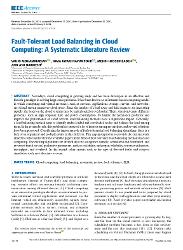| dc.contributor.author | Mohammadian, Vahid | |
| dc.contributor.author | Navimipour, Nima Jafari | |
| dc.contributor.author | Hosseinzadeh, Mehdi | |
| dc.contributor.author | Darwesh, Aso | |
| dc.date.accessioned | 2023-10-19T15:11:53Z | |
| dc.date.available | 2023-10-19T15:11:53Z | |
| dc.date.issued | 2022 | |
| dc.identifier.issn | 2169-3536 | |
| dc.identifier.uri | https://doi.org/10.1109/ACCESS.2021.3139730 | |
| dc.identifier.uri | https://hdl.handle.net/20.500.12469/5264 | |
| dc.description.abstract | Nowadays, cloud computing is growing daily and has been developed as an effective and flexible paradigm in solving large-scale problems. It has been known as an Internet-based computing model in which computing and virtual resources, such as services, applications, storage, servers, and networks, are shared among numerous cloud users. Since the number of cloud users and their requests are increasing rapidly, the loads on the cloud systems may be underloaded or overloaded. These situations cause different problems, such as high response time and power consumption. To handle the mentioned problems and improve the performance of cloud servers, load balancing methods have a significant impact. Generally, a load balancing method aims to identify under-loaded and overloaded nodes and balance the load among them. In the recent decade, this problem has attracted a lot of interest among researchers, and several solutions have been proposed. Considering the important role of fault-tolerant in load balancing algorithms, there is a lack of an organized and in-depth study in this field yet. This gap prompted us to provide the current study aimed to collect and review the available papers in the field of fault tolerance load balancing methods in cloud computing. The existing algorithms are divided into two categories, namely, centralized and distributed, and reviewed based on vital qualitative parameters, such as scalability, makespan, reliability, resource utilization, throughput, and overhead. In this regard, other criteria such as the type of detected faults and adopted simulation tools are taken into account. | en_US |
| dc.language.iso | eng | en_US |
| dc.publisher | IEEE-Inst Electrical Electronics Engineers Inc | en_US |
| dc.relation.ispartof | Ieee Access | en_US |
| dc.rights | info:eu-repo/semantics/openAccess | en_US |
| dc.subject | Algorithms | En_Us |
| dc.subject | Resources | En_Us |
| dc.subject | Optimization | En_Us |
| dc.subject | Environment | En_Us |
| dc.subject | Mechanisms | En_Us |
| dc.subject | Service | En_Us |
| dc.subject | Model | En_Us |
| dc.subject | Cloud computing | en_US |
| dc.subject | Load management | en_US |
| dc.subject | Fault tolerant systems | en_US |
| dc.subject | Fault tolerance | en_US |
| dc.subject | Systematics | en_US |
| dc.subject | Time factors | en_US |
| dc.subject | Scheduling | en_US |
| dc.subject | Cloud computing | en_US |
| dc.subject | load balancing | en_US |
| dc.subject | systematic review | en_US |
| dc.subject | fault tolerance | en_US |
| dc.subject | SLR | en_US |
| dc.title | Fault-Tolerant Load Balancing in Cloud Computing: A Systematic Literature Review | en_US |
| dc.type | review | en_US |
| dc.identifier.startpage | 12714 | en_US |
| dc.identifier.endpage | 12731 | en_US |
| dc.authorid | Jafari Navimipour, Nima/0000-0002-5514-5536 | |
| dc.identifier.volume | 10 | en_US |
| dc.department | N/A | en_US |
| dc.identifier.wos | WOS:000751358800001 | en_US |
| dc.identifier.doi | 10.1109/ACCESS.2021.3139730 | en_US |
| dc.identifier.scopus | 2-s2.0-85122598020 | en_US |
| dc.institutionauthor | N/A | |
| dc.relation.publicationcategory | Diğer | en_US |
| dc.authorwosid | Mohammadian, Vahid/JDW-7770-2023 | |
| dc.authorwosid | Hosseinzadeh, Mehdi/GWV-3822-2022 | |
| dc.authorwosid | Jafari Navimipour, Nima/AAF-5662-2021 | |
| dc.khas | 20231019-WoS | en_US |
















